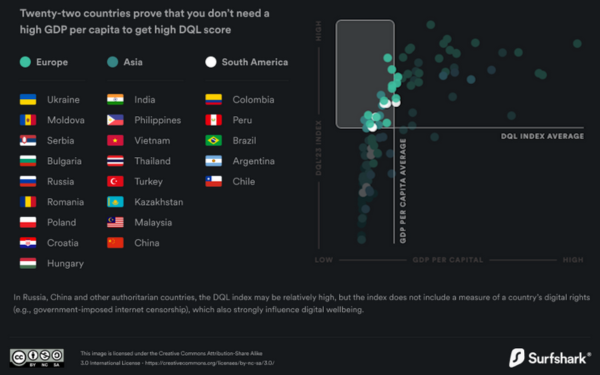
Digital Wellbeing Index
Digital wellbeing integrates seamlessly into our entire existence. Screen time, often seen merely as a diversion or a tool for productivity, is actually a significant part of our reality. The digital realm does not compete with the physical. Instead, it complements it; offering new ways to interact, learn, and engage with the world.
We spend, on average, nearly seven hours a day engaged with screens, using them for a multitude of purposes. While some argue that our digital interactions hold as much weight as our physical ones, this view might distort our understanding of the world. The real question is why do we compartmentalize our existence instead of acknowledging that true life unfolds only when we are fully present in our reality?
The distinction between our online and offline lives has become increasingly artificial. What if some of the hours in front of screens contribute to our overall wellbeing when we are conscious and aware? And perhaps are as consequential as our real-world interactions. This suggests we not differentiate between digital and physical experiences but embrace them as a unified aspect of life.
SurfShark’s 2023 Digital Quality of Life Index brings this concept to the forefront by evaluating digital wellbeing across the globe. The study, encompassing 121 countries representing 92% of the global population, delves into the nuances of digital wellbeing.
Acknowledging that it varies across different regions, much like physical wellbeing. This analysis uses five crucial metrics to gauge the digital health of a nation: Internet affordability, Internet quality, E-infrastructure, E-security, and E-government.
Mapping Digital Wellbeing
These metrics collectively paint a picture of how digital services, ranging from internet access to online government interactions, impact the daily lives of people. For instance, internet affordability and quality directly influence how people communicate, work, and interact with content, while E-infrastructure and E-security shape the safety and versatility of online experiences.
The digitization of government services, under the E-government metric, plays a role in reducing bureaucracy and enhancing transparency. But when the very systems are broken, we see more clearly what is truly going on. Maybe questioning who we trust.
Europe, with France as a standout, leads in providing high-quality digital wellbeing. But the report also recognizes countries from Asia and Eastern Europe. Notably, Singapore and Japan, ranking 10th and 16th respectively, emerge as the top non-European countries in digital well-being.
These nations demonstrate that financial wealth is not the sole predictor of digital prosperity. They show that thoughtful application of resources and policies result in high digital quality of life. And by doing so, challenging more affluent nations to consider their approach to digital wellbeing.
Improvements in e-government are particularly influential in enhancing digital wellbeing. In contrast, the cost of internet access is less impactful. Investments in digital governance and security yield more substantial benefits to a nation’s digital health than merely focusing on lowering internet costs.
Globally, the internet is more affordable than last year despite rising inflation. That means people have to work less time a month to afford mobile and fixed internet.
Holistic Integration
Digital wellbeing mirrors the health of a nation in the digital realm, prompting us to consider our perceptions, measurements, and investments in digital spaces. It underscores the need to weave digital wellbeing into the fabric of our lives, calling for mindful nurturing and development to ensure accessible and beneficial technology integration for all.
The true measure of a digital system’s power rests in its ability to foster synergy and manage entropy within itself or other systems. Its effectiveness and impact are marked by its ability to encourage collaboration and nurture connections.
The real potential lies not just in social media platforms but in our approach to using them. We’ve molded these platforms for promotion and visibility, sidelining the creation of genuine connections. This trend has led to a culture fixated on popularity and influence, often breeding issues like bullying. We have a chance to move beyond mere consumption towards interactive dialogue and meaningful engagement.
Our approach to wellbeing, akin to that of nations, is holistic, encompassing emotional, mental, physical, social, and spiritual aspects of an individual.
Ultimately, the way we interact digitally is a choice we make. We possess the creative capacity to integrate technology harmoniously with the core elements of our humanity—trust, relationships, and community. This integration is the pathway to a thriving, interconnected world.


